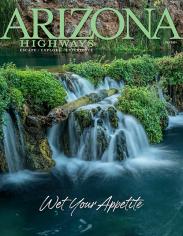Arizona is 99.7 percent dry land and lacks an ocean coastline, so around here, islands are hard to come by. There are buttes that jut from Lake Powell, Lake Mead and some of the state’s other man-made lakes, and in Lake Havasu City, a peninsula was turned into an island to attract land buyers in the 1970s. For the most part, though, land naturally surrounded by water isn’t part of Arizona’s DNA.
It might seem strange, then, that Southeastern Arizona is home to islands of a different kind. They’re much older than Arizona Highways, but it was in this magazine, in March 1943, that naturalist Natt N. Dodge suggested the name by which these geographical oddities are known today. “When Tertiary disturbances buckled the Earth’s crust to form the Chiricahua Mountains,” Dodge wrote, “Nature’s selection of a location placed this chain at some distance from other ranges — a mountain island in a desert sea.”
Later shortened to “sky island” by nature writer Weldon Heald, the term now refers to an isolated mountain range surrounded by an environment radically different from the one found atop the range. In Southeastern Arizona and neighboring parts of New Mexico and Mexico, dozens of ranges fit the criteria. Amid the arid Sonoran and Chihuahuan deserts, these ranges, collectively known as the Madrean sky islands, are home to plant communities and animal species not found in the hot desert below — or, in some cases, anywhere else on Earth.
The mountains’ wonders are something Dan Fischer knows well. During a 33-year engineering career, Fischer spent his spare time exploring Arizona, including its sky islands, and making photos of wildlife and landscapes. After he retired, he lived for 20 years in a rock house in the Chiricahua Mountains, one of the highest ranges in the Madrean sky islands. Fischer’s photos formed the basis for Sky Islands: Encountering a Landlocked Archipelago, a book released last year by Sky Island Press.
“I’ve always been interested in natural history,” says Fischer, who’s 88 now and lives in Tucson. “As I expanded my horizons while traveling around, I realized what a tremendous biological area this is.” The idea for the book, he says, grew out of his interest in ornithology and a desire to show a more complete biological picture: “Everything’s tied together. It’s not just birds. The birds wouldn’t be here without the trees, the water, all of it.”
The Madrean sky islands are the only place in Arizona where you’ll find the lemon lily (Lilium parryi), the only true lily native to the state. The Mount Graham red squirrel, named for the highest peak in the Pinaleño Mountains of Eastern Arizona, lives only in that range. And numerous bird species that are more prevalent in Mexico can be spotted in Southeastern Arizona’s high country. Even jaguars, thought to have been extirpated from the state decades ago, have been spotted in the mountains in recent years.
For residents or visitors looking to get a taste of the sky islands, Fischer has three suggestions. His former home in the Chiricahuas offers geological wonders and plenty of species diversity. Mount Lemmon, the high point of the Tucson area’s Santa Catalina Mountains, is easily accessed via a paved road that passes through six vegetation communities, starting with the Sonoran Desert and ending in a mixed-conifer forest. And Madera Canyon, in the Santa Rita Mountains southeast of Tucson, has a lower elevation but harbors hundreds of the border region’s bird species, including the magnificently colored elegant trogon.
For Fischer himself, though, it’s hard to choose a favorite memory, but he recalls nights spent atop isolated peaks, surrounded by that seemingly endless desert sea — always with a camera and binoculars in hand. “Just so many wonderful experiences,” he says. “It’s been a lifelong joy to do all this.”

